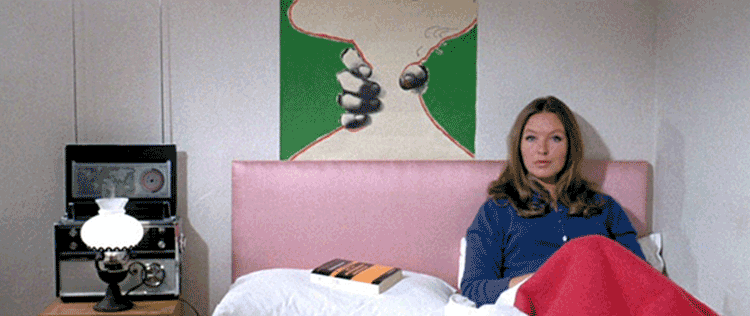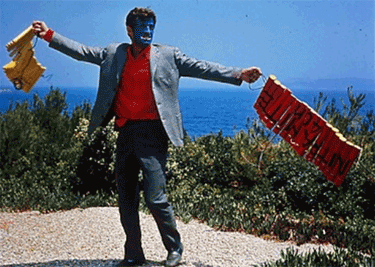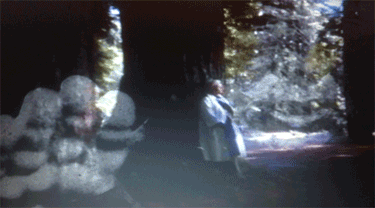Lucidno
| Annihilation of the artist symbolized by the death of his protagonist also serves the purpose of liberating him from the limitations of the given art and releasing into the freeness of being, a state of mind in which literally everything becomes a piece of art worth astonishment and in which creation becomes guided by Godard's norm, "Things are there, why manipulate them" (Histoire(s) du cinema- Chapter 3a: The Coin of the Absolute).This, in a way, is the logical extension of DzigaVertov's philosophy according to which the most authentic cinema grows not from a fictional construction of the filmed material, but from an impromptu immersion of the eye of the camera into the world, as spontaneous, unpredictably evolving and tuned to an eye for the moment as it can be. In its extreme, terminal destination, this approach to creation echoes the way of Friedrich Munro from Wenders' Lisbon Story and his shooting movies by walking around the city with a camera tied to his back, sticking on to Nabokov's finding patches of butterfly's wings more artistically pleasing than "dark pictures, thrones, the stones that pilgrims kiss, poems that take a thousand years to die"vand seeing everything as an equally blissful art – preconceived or spontaneously captured, directed or natural, structured or arbitrary. Through one such liberation, the viewer immortalized in the following line from Histoire(s) du cinema (Chapter 3a: The Coin of the Absolute) becomes rescued from the desensitization of the senses, i.e., blindness that confinement in the cinematic world imminently leads to: "A German, Erich Pommer, founder of Universal, today Matsushita Electronics, declared, 'I will make the whole world cry in their armchair'. Can we say he succeeded? On the one hand, it is true that newspapers and television all over the world only show death and tears. On the other end, those who stay and watch television have no tears left to cry. They unlearned to see".
Is this the only thing that Godard wishes to tell us with this symbolic act of obliterating the subject, then panning the camera away from it and toward the world, or an open sea as in Le Mépris or Peirrot le fou, bearing resemblance to what Fellini also did in the 60s in Satyricon and in Juliet of the Spirits? Certainly not. In fact, when the artist is guided by the precept with which we opened this discourse, when she creates in concert with her intuition, allowing the work of art to create the artist as much as the artist creates the given work of art, she is bound to realize the multiplicity of meanings that have become embedded in the semantic substratum of the product of her creation, all without the artist's explicit intention. In fact, what distinguishes cinema from other forms of art is the infinite diversity of meanings ascribable to every scene and its element - like in real life, where one sees eruptions of subtle positivism, another might see suppressed bitterness; where one sees lectures in morality, another might see cynicism, and so forth. In fact, one might argue that, in view of this correspondence between cinema and life, celluloid tapes should feel obliged to engrain such multifaceted enactments; conversely, a naïve imposition of semantic linearity ought to be considered a cinematic sin par excellence. Oftentimes in addition to semantic multiplicity, there is also the contradiction – for example, the subject of prostitution frequently employed by Godard could be seen as submissive selling of one's soul to the devil for the sake of acceptance by the society or as being enlightened in nature, |
coinciding with a wish to make everyone content even at the cost of one's own descent into moral lowlands, the two interpretations being diametrically opposite, the former utterly negative and the latter utterly positive with respect to the life of the protagonist. As if being lured by the simultaneous cursedness and blessedness of Sophocles' Oedipus at Colonus, Godard must have intuitively sensed that the embodiment of contradictions is a sign of greatness, in life yes, but all the more so in arts. Hence, there is no doubt that the repeated resorting to the subject of prostitution was Godard's way of attacking the streams of sell-out phoniness spilling out like vomit from corporate offices, grocery stores, coffee shops, concert venues, billboards, ads and TV, being the reason why he has heartily refused to appear on it all throughout his lifetime, but there is also a perpetual wonder whether prostitution as giving oneself wholly to another has also been a way of liberating the spirits of some of his favorite female protagonists. Or take the ambiguous 360 o panning shot preceding the final shot of 2 ou 3 choses que je sais d'elle – does it prove that the protagonist, Juliette Janson has finally become the world, the way she had dreamt of, or it demonstrates a sense of being more lost than ever in this inhumane, mechanical, soulless world of skyscrapers and sickening staginess? But that is the sign of the greatness of one's work – it cannot be preplanned and it will keep the quarreling critics busy for ages to come.
Relying on one's intuitive skills in creation is, in a way, similar to handing Nature a part of the paintbrush with which the images are drawn and making sure the co-creational process involving oneself and the spirit of the world begins to resemble Escher's painting of two hands, one drawing the other, confounding the viewer in his every attempt to decipher who is drawing whom. This approach whereby one hands over one's authority, forsakes the role of anemperorand humbly joins creative forces with multiple others, is the only one that deserves the epithet of authentic when it comes to the art of filmmaking. For, to become a filmmaker is to renounce any cravings to directly copy one's visions onto the screen and be aware that, whatever the vision one wishes to have projected on the celluloid tape, the result will always be 1 + 2 + 3 = 4vi, as Godard put it in attempt to tell us that the actualization of the abstract in the cinematic realm always entails a partial fading of the abstract.Therefore, what the directorial element of the art of cinema teaches is creation in convergence with other people's visions and propensities. "False love means I don't change; true love means both you and I change", says Juliette in2 ou 3 choses que je sais d'elle, describing the essence of the art of filmmaking bona fide: one must not rigidly impose one's ideas onto the crew and the actors, but must live and change with them, making every take a surprise, a step leading to an unknown and unforeseen direction. Vuk USKOKOVIĆ |

2 ou 3 choses que je saisd'elle (1967). The movie marks a turning point in Godard's career, being his first cinematic essay in which images are accompanied by the narration using his own voice and in which characters are repeatedly directed to break the fourth wall by gazing directly at the camera and introducing themselves to the viewer.
_____________________________
v Gould, Stephen Jay – "No Science without Fancy, No Art without Facts: The Lepidoptery of Vladimir Nabokov", In: I Have Landed: The End of a Beginning in Natural History, Harmony Books, New York, NY (2002).
vi Godard, Jean-Luc – "My Approach in Four Movements", In: Godard on Godard: Critical Writings by Jean-Luc Godard, edited by Jean Narboni and Tom Milne, Introduction by Richard Roud, Da Capo Press, New York, NY (1968), pp. 242.



